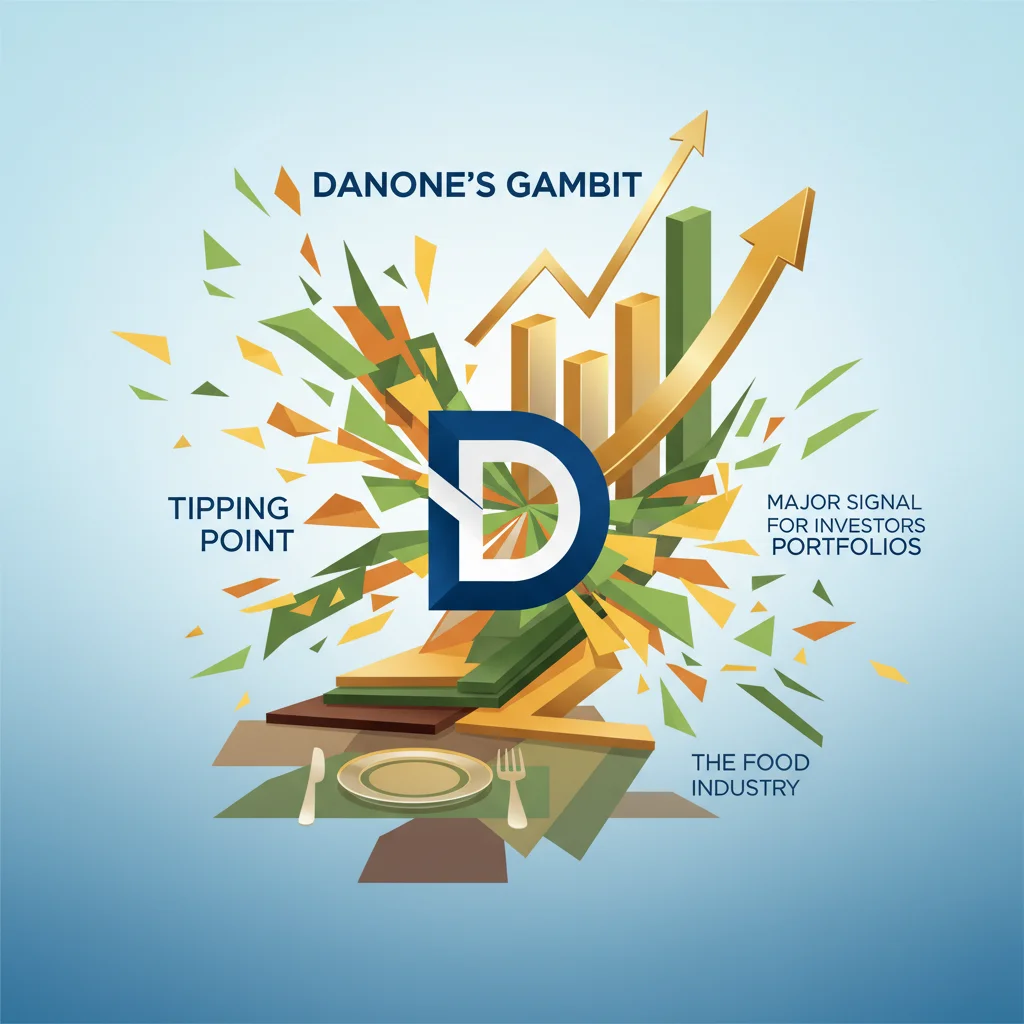
Danone’s Gambit: Why the Food Industry’s ‘Tipping Point’ Is a Major Signal for Investors
The Seismic Shift Reshaping Our Plates and Portfolios
In the world of global business, few sectors are as fundamentally tied to human existence as the food industry. It’s a colossal market, seemingly immutable and always in demand. Yet, according to Antoine de Saint-Affrique, the chief executive of the French food giant Danone, this bedrock industry is standing on the precipice of radical change. He describes the current moment as a “tipping point,” driven by powerful demographic and societal shifts that are forcing a complete re-evaluation of how food is produced, marketed, and consumed. This isn’t just about new yogurt flavors; it’s a fundamental realignment with profound implications for the global economy, corporate strategy, and, most importantly, for those engaged in investing and analyzing the stock market.
For decades, the formula for success in the consumer-packaged goods (CPG) space was straightforward: scale, efficiency, and brand dominance. But the ground is moving. A confluence of aging populations in Western markets, the rise of health-conscious millennials and Gen Z, and a growing governmental focus on public health crises like obesity is creating a new paradigm. De Saint-Affrique’s comments highlight a critical juncture where legacy companies must either pivot or risk obsolescence. For business leaders, finance professionals, and investors, understanding the depth of this transformation is no longer optional—it’s essential for navigating the future of consumer-driven markets.
The Twin Engines of Change: Demographics and Regulation
What exactly is fueling this industry-wide reckoning? The forces at play are not fleeting trends but deep, structural changes in society and governance.
A New Consumer Profile Emerges
The first engine is a dramatic demographic evolution. In many developed nations, populations are aging, leading to a greater focus on health, longevity, and nutrition tailored to specific life stages. Simultaneously, younger generations have entered the market with a completely different set of values. They demand transparency, sustainability, and products that actively contribute to their wellness. The vague “low-fat” labels of the 90s have been replaced by a desire for clean labels, plant-based options, and functional foods that offer benefits beyond basic nutrition.
This isn’t just about perception; it’s about a fundamental shift in the economics of consumer choice. The modern consumer is often willing to pay a premium for products that align with their health and ethical values, disrupting traditional price-based competition.
The Trump-China Trade War: Decoding the Strategy Behind the Spectacle
The Regulatory Hammer Falls
The second, and perhaps more immediate, force is regulatory pressure. De Saint-Affrique specifically pointed to the U.S. government’s intensified efforts to combat obesity and reduce the use of certain additives in food products. This is a game-changer. When governments step in, the market is compelled to respond. The White House Conference on Hunger, Nutrition, and Health has signaled a new era of scrutiny, moving public health from a talking point to a policy priority. This creates both a significant risk for companies reliant on legacy product formulations high in sugar, salt, and fat, and a massive opportunity for those, like Danone, who are leaning into the health and wellness space.
Danone’s “Renew” Strategy: A Case Study in Corporate Adaptation
Facing these headwinds, Danone is not standing still. Under de Saint-Affrique, who took the helm in 2021, the company launched its “Renew Danone” strategy—a comprehensive plan to pivot the €28bn-in-sales behemoth towards a more resilient, health-focused future. This isn’t just a marketing campaign; it’s a strategic overhaul designed to align the company’s portfolio with the new consumer and regulatory reality.
The strategy is built on several key pillars, which offer a blueprint for how a legacy CPG company can attempt to navigate this new landscape. A closer look at these pillars reveals a clear focus on high-growth, high-value categories.
| Pillar of “Renew Danone” Strategy | Strategic Objective & Rationale |
|---|---|
| Portfolio Rotation | Systematically selling off underperforming or misaligned brands (e.g., Horizon Organic milk in the U.S.) and acquiring businesses in high-growth areas. This sharpens focus and reallocates capital more effectively. |
| Focus on Health & Wellness | Doubling down on core strengths in probiotics, yogurt, and plant-based products. This directly addresses the consumer demand for functional, health-promoting foods and aligns with regulatory tailwinds. |
| Medical Nutrition Expansion | Investing heavily in its medical nutrition division, which caters to the needs of an aging population and those with specific health conditions. According to the CEO, this is a sector with “extraordinarily high barriers to entry.” |
| Operational & R&D Excellence | Improving supply chain efficiency and investing in scientific research to develop the next generation of healthy products. This includes exploring the microbiome and its link to overall health. |
Danone’s approach is a clear signal to the stock market that it intends to lead, not follow. By divesting from slower-growth dairy and investing in specialized nutrition, the company is making a calculated bet that the future of food lies in its health benefits, not just its taste or convenience. This strategic repositioning has already involved significant portfolio changes, including the sale of its U.S. organic milk business and the recent acquisition of a leading probiotics company. (source)
Beyond the Ceasefire: Gaza's Power Shift and the Economic Tremors for Investors
The Fintech and Blockchain Angle: Technology’s Role in the New Food Economy
The transformation of the food industry also intersects with the world of financial technology and innovation in surprising ways. As consumers demand more than just marketing claims, technology is becoming a critical enabler of trust and transparency.
Consider the challenge of proving that a product is truly “organic,” “sustainably sourced,” or “clean label.” This is where emerging technologies like blockchain come into play. A blockchain-based supply chain ledger can provide an immutable, transparent record of a product’s journey from farm to shelf. A consumer could theoretically scan a QR code on a yogurt pot and see exactly where the milk came from, how the fruit was sourced, and every step in between. For companies like Danone, leveraging such technology could be a powerful differentiator, turning brand promises into verifiable facts.
Furthermore, the rise of ESG (Environmental, Social, and Governance) investing, powered by sophisticated fintech platforms, is changing how capital is allocated. Investors are increasingly using these platforms to screen for companies that align with their values. A company’s public health footprint is becoming a key “S” (Social) metric. Danone’s explicit strategy to improve the nutritional profile of its portfolio positions it favorably in the eyes of this growing class of investors. Modern banking and asset management firms are building entire products around these themes, meaning corporate strategies that embrace health and wellness are not just good for society—they are becoming essential for attracting capital.
What This “Tipping Point” Means for Your Investment Strategy
For anyone engaged with the markets, Danone’s story is a microcosm of a much larger shift. The “tipping point” in the food industry offers several key takeaways for a modern investment thesis:
- Look Beyond the Balance Sheet: Traditional financial analysis is no longer enough. Investors must now assess a company’s ability to adapt to deep societal and regulatory trends. Is the company’s portfolio aligned with the future of consumer demand, or is it defending a declining territory?
- Regulation as a Catalyst: Pay close attention to governmental policy shifts. In sectors like food, healthcare, and energy, regulatory actions can create new market leaders and render old business models obsolete overnight.
- The Value of Intangibles: Brand trust, transparency, and alignment with consumer values are becoming powerful economic assets. Companies investing in these areas, even at the cost of short-term profits, may be building more resilient long-term businesses.
The lines between a company’s social impact and its financial performance are blurring. The new landscape of economics dictates that long-term profitability is intrinsically linked to a company’s role in society. The challenges posed by obesity, climate change, and demographic shifts are no longer external factors; they are core business risks and opportunities.
The Unseen Threat to Your Portfolio: How Australian Superweeds Could Derail the Global Economy
Antoine de Saint-Affrique may have been talking about Danone, but his message was a wake-up call for the entire CPG sector and its investors. The “tipping point” is here. The companies that recognize this and strategically realign themselves for a future defined by health, transparency, and purpose will be the ones that deliver sustainable growth and value in the decades to come. The rest risk becoming relics of a bygone era.


